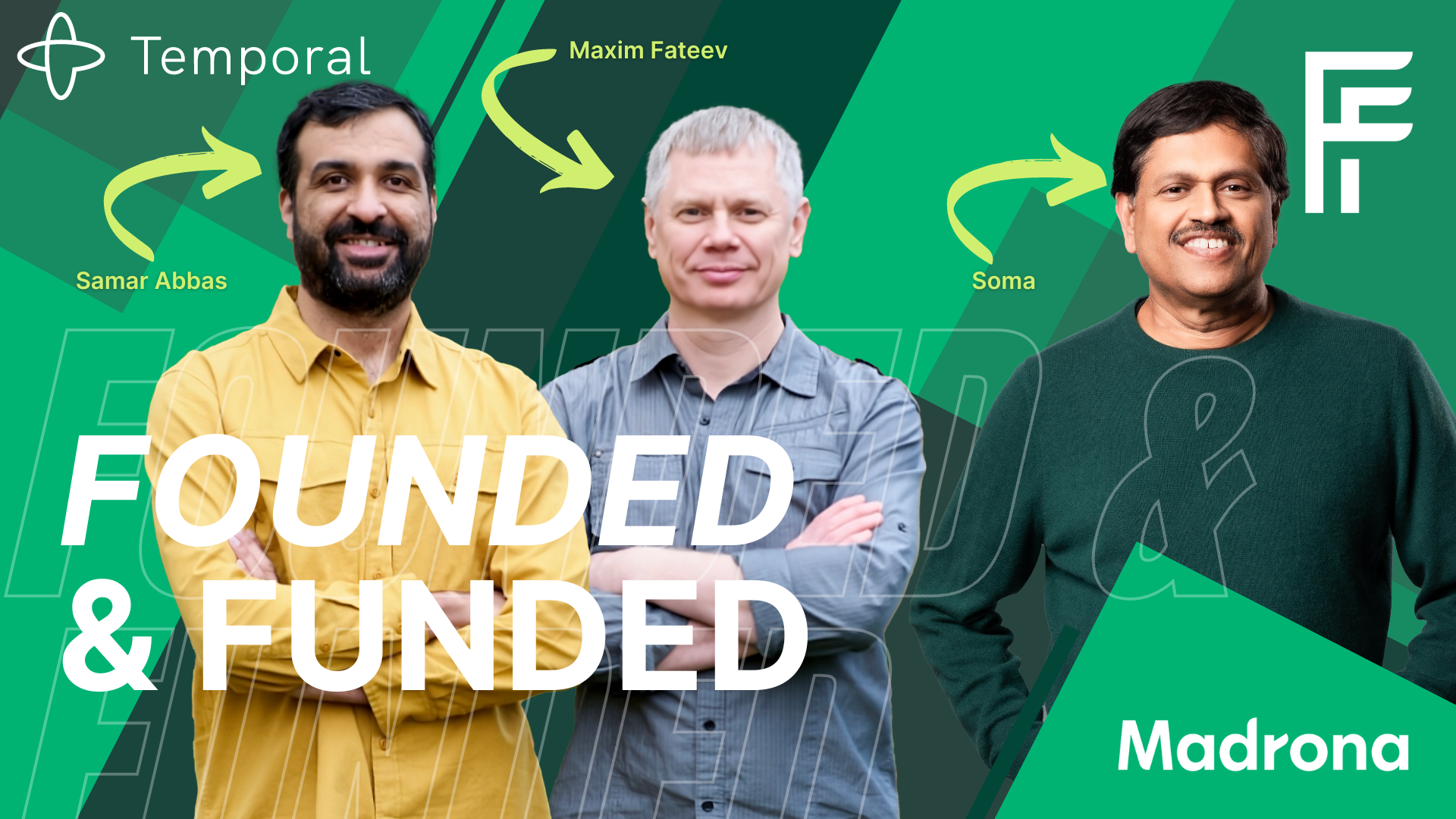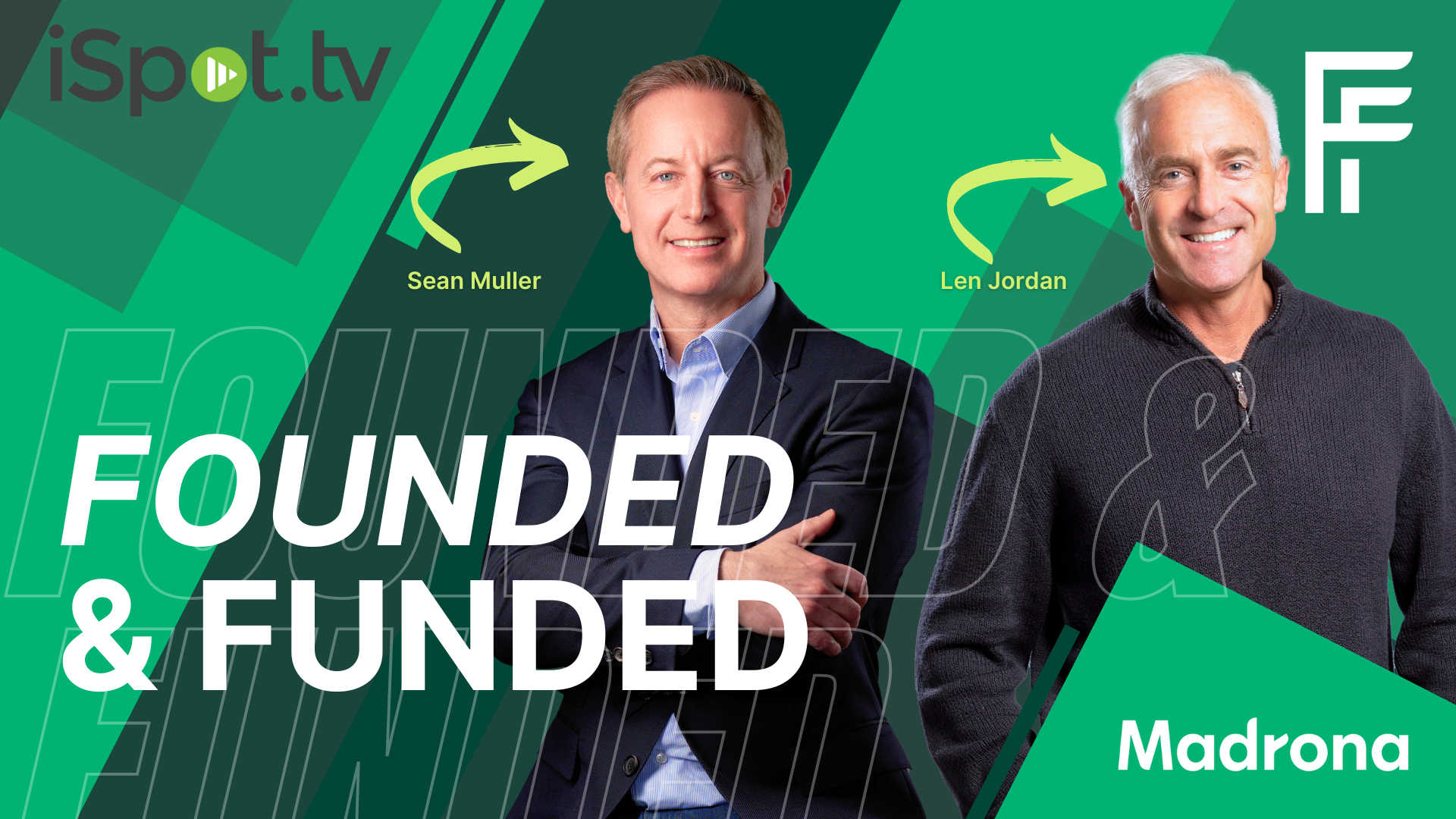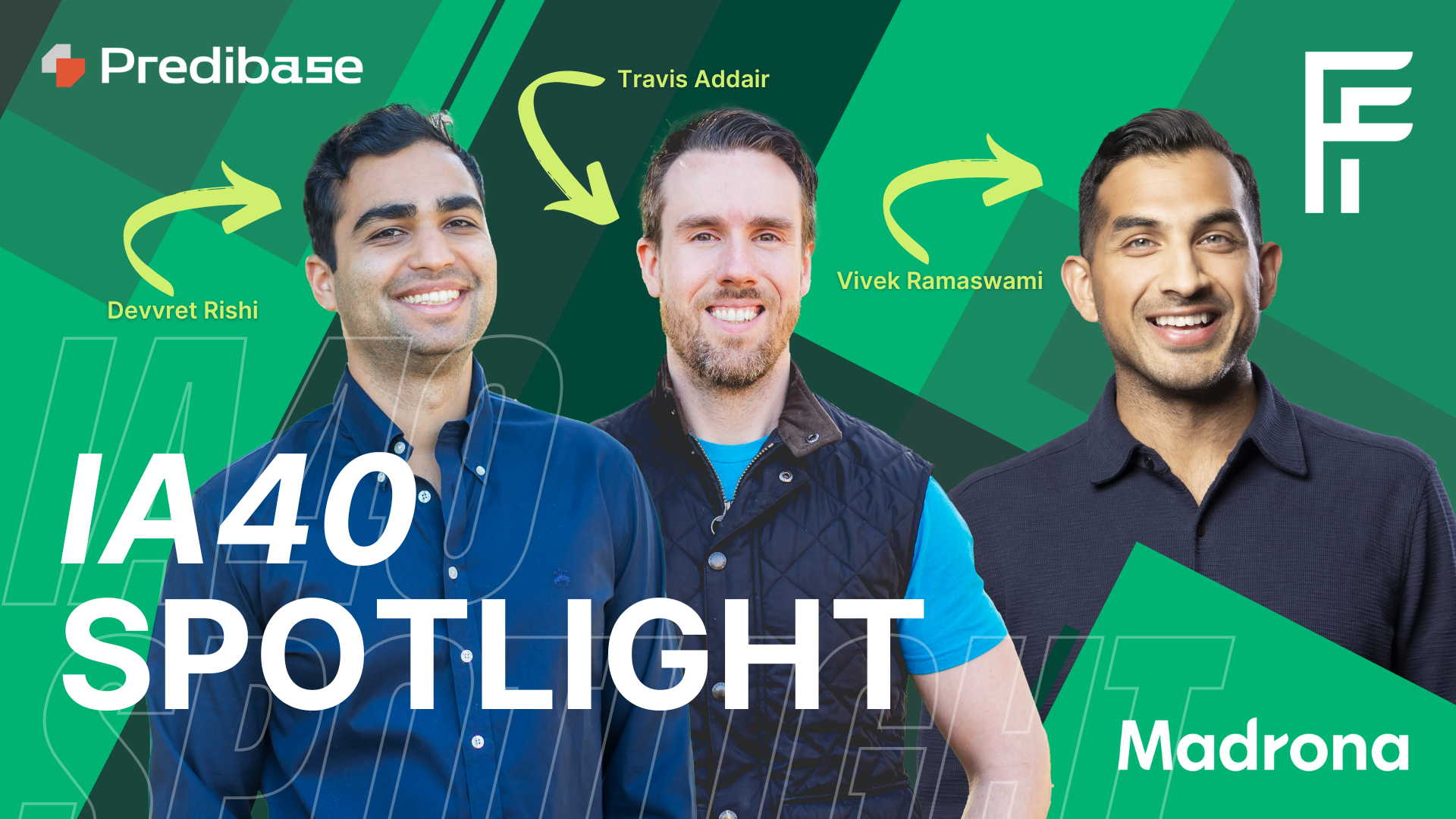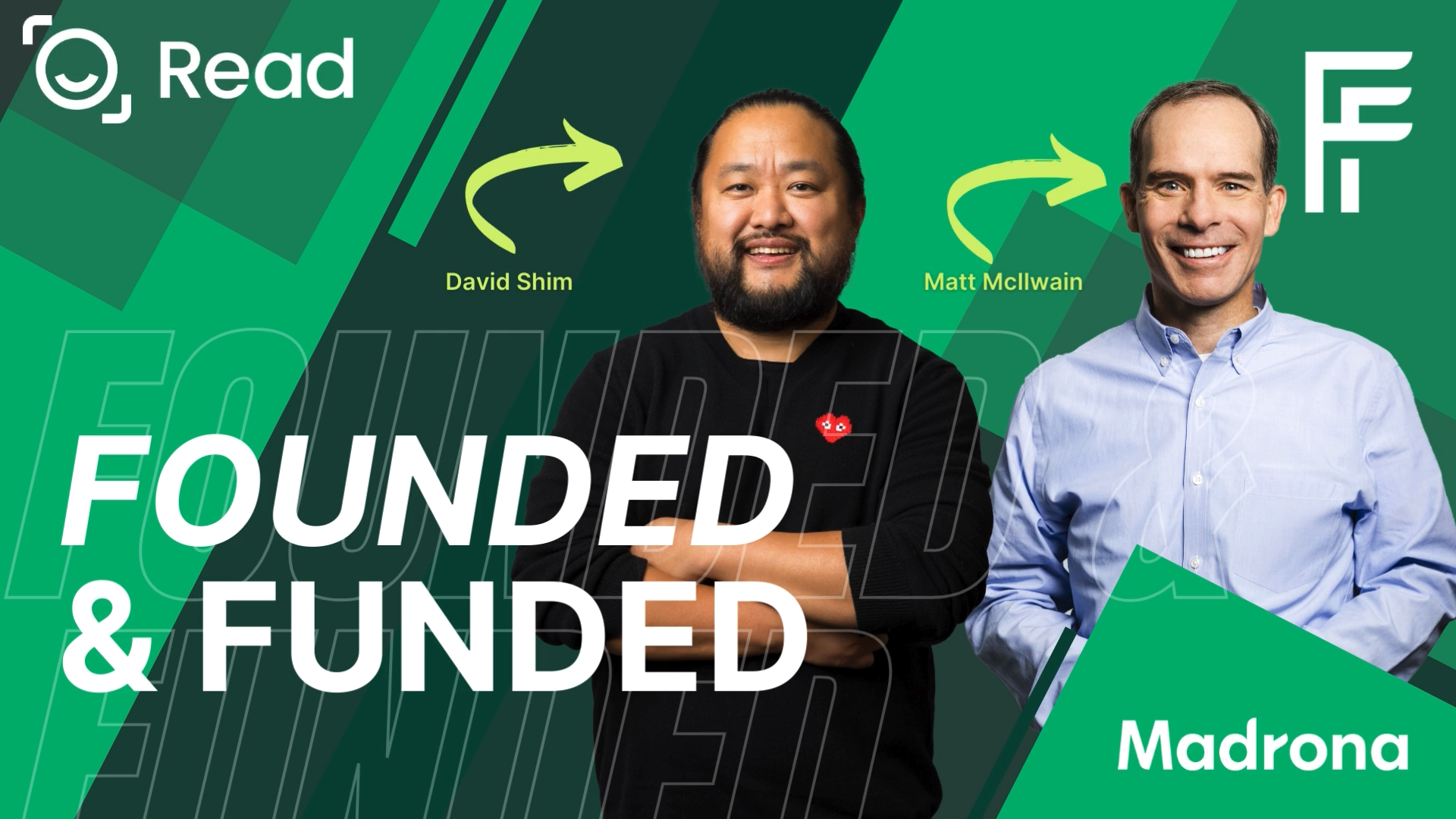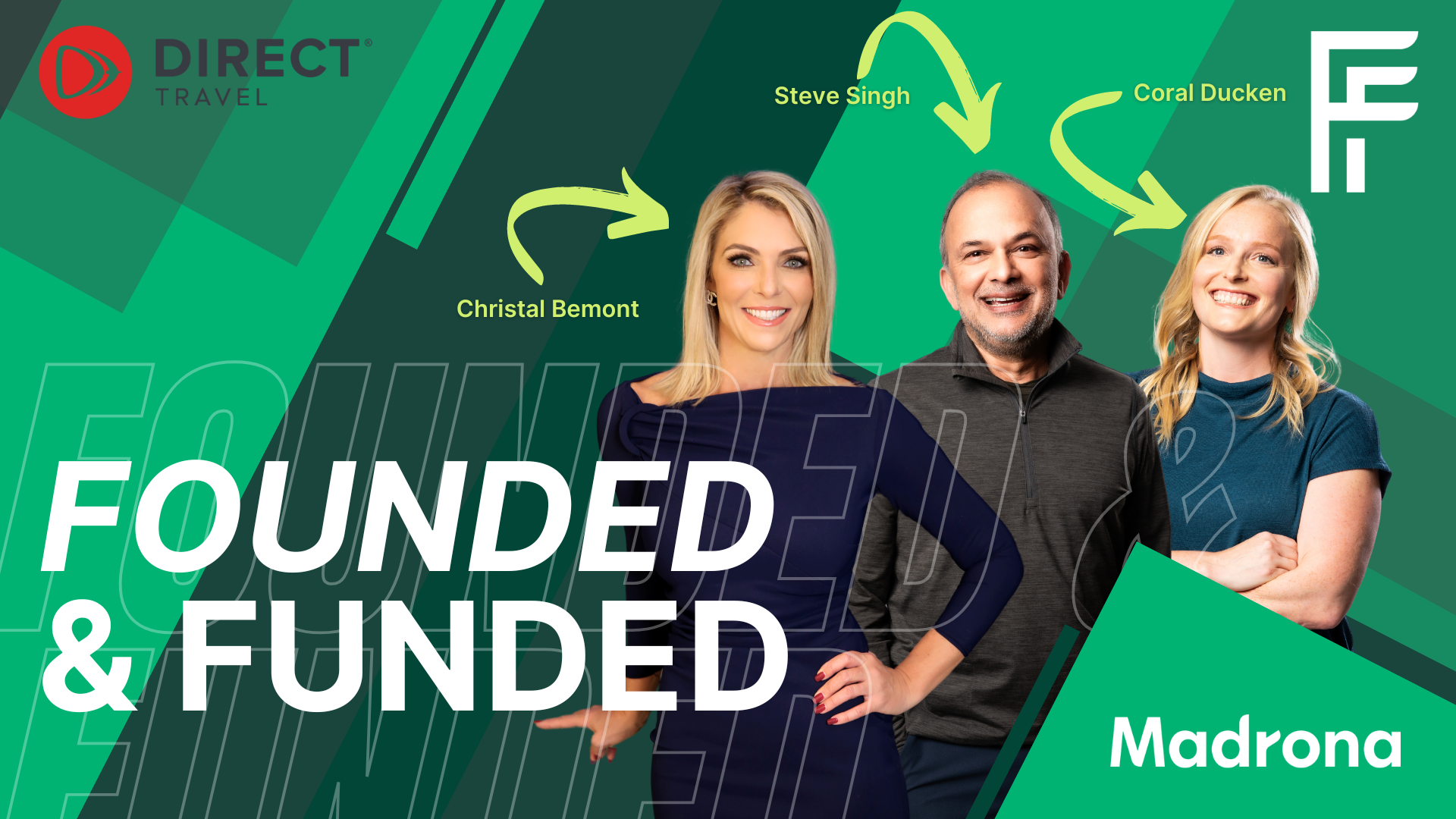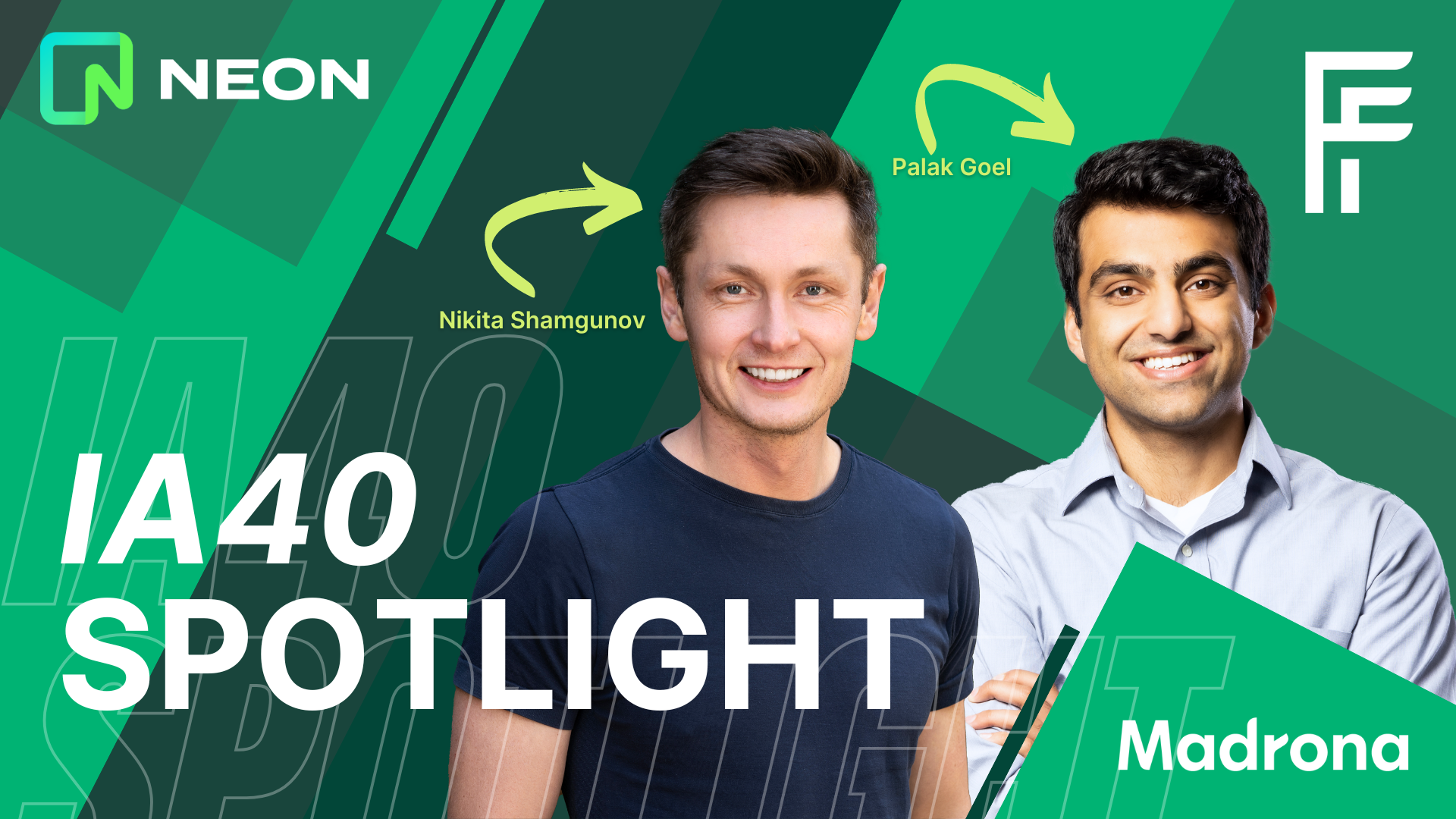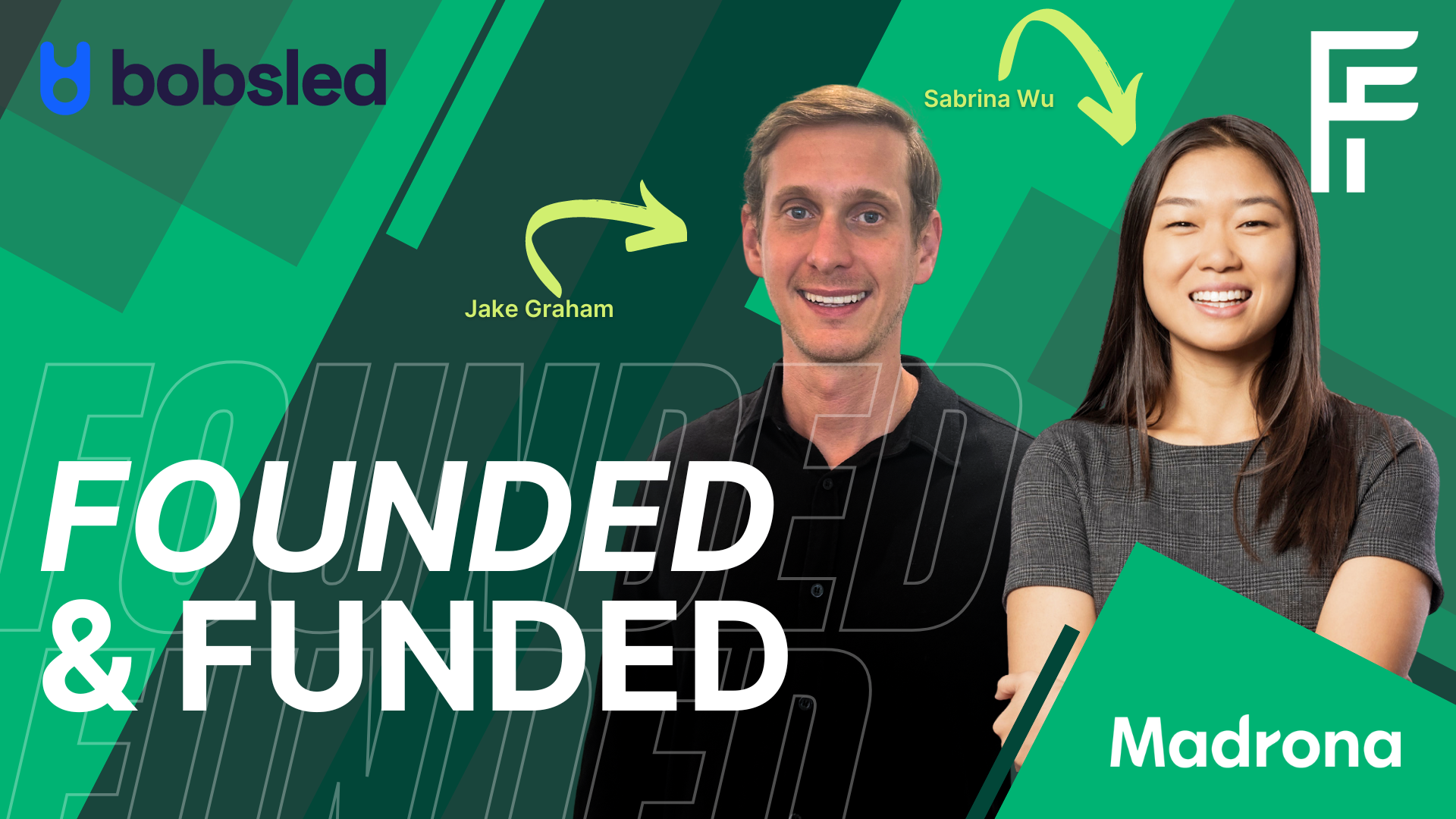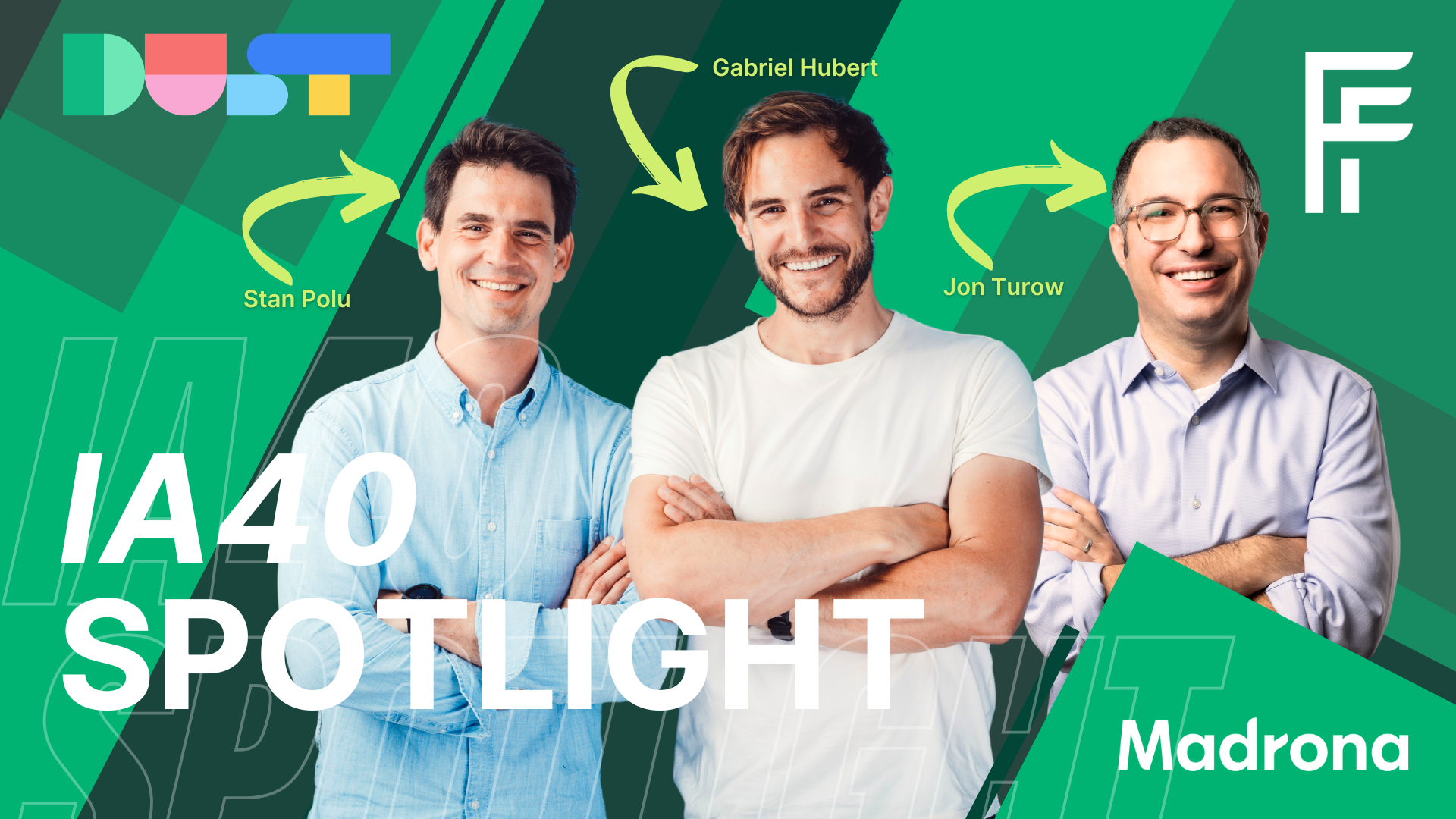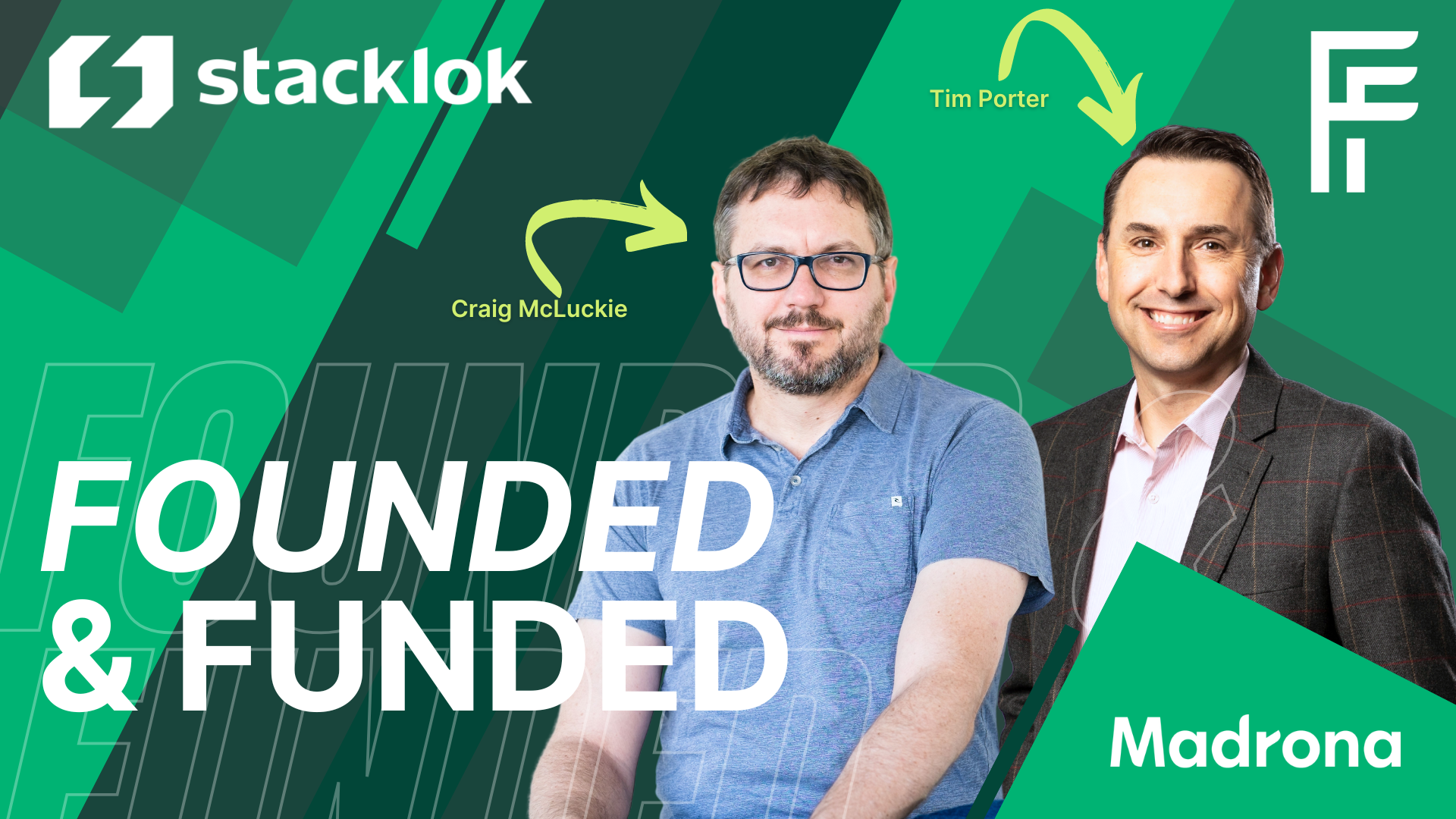Listen on Spotify, Apple, and Amazon | Watch on YouTube
In this episode of Founded & Funded, Madrona Partner Chris Picardo sits down with Jamie Lazarovits, the co-founder and CEO of Archon Bio. Madrona partnered with Archon truly on day one to spin out from David Baker’s lab in the Institute for Protein Design at the University of Washington. The company leveraged cutting-edge protein design from the IPD to develop a brand new therapeutic modality with the potential to massively transform how we think about treating many categories of disease.
Jamie and Chris dive into how Jamie pivoted from bootstrapping deep tech investments to biotech, how he landed at the Institute for Protein Design working with David Baker — who just won a Nobel Prize, how to navigate translating an academic project into a commercial product with a clear business model, picking a co-founder and building a team, and of course, how he’s building novel types of drugs that will get more treatments to more patients.
This is a great conversation for anyone interested in launching a startup, whether biotech or not.
This transcript was automatically generated and edited for clarity.
Jamie: It’s great to be here. It’s exciting to finally have the opportunity to talk about who we are. We’ve been maybe not that great of a kept secret, but it does feel good to finally share who we are.
Chris: You have told me many times that you started in the startup and tech world by bootstrapping investments into deep tech companies. How the heck did that happen?
Jamie: My best friend when I was in my late teens, he started a software company and he happened to do pretty well. I had some money from my tuition as well as from scholarships and decided to start day trading. This was exciting because we had never played around with something like this before, but we thought, why not do something more mathematical and see if we can figure out trends in the market? At the time, we were playing with penny stocks and the rare earth market, and that was a lot of fun. We did relatively well, but the problem was we realized it was gambling at the end of the day and we weren’t able to see underneath the hood to know if these companies had substance. We also realized we weren’t excited about just making money. We wanted to understand how these people thought about what they were doing.
My friend had this software company based out of Waterloo in Canada, which is a very big engineering school, and we started speaking to a lot of early-stage founders who had amazing ideas but didn’t quite have the right capacity to communicate what they were doing. My friend and I were interested in understanding what was going on under the hood, so we decided to take our tuition money, the money we made from day trading, and the money he made from his company to start investing in these companies. We ended up doing this in about 10 different companies. Some of them have grown to over 100 employees with multiple tens of millions of dollars a year in revenue.
Chris: It’s fun that you got a little taste of our side of the table.
Jamie: Totally.
Chris: Some of those companies are still going. I think that’s super interesting. Not many people have this sort of accidental venture capitalist interlude between graduation and going to get your PhD, but I think it’d be interesting to talk about how you made that transition. You were working with these deep tech companies and then you decided that you’re going to go to grad school.
Jamie: I was working with these deep tech companies. A lot of them were focused on AI. I came from Toronto, so obviously, machine learning is very big over there — they are big in AI and in hardware. It was interesting thinking about how you translate deep tech products to solve real-world problems. I was working at Harvard, and my roommate’s mom invented this device that profiles maternal blood. Instead of a woman having to go for an amniocentesis, you were able to profile her blood, and then you could determine if potentially there was something wrong with her child.
I found this amazing because it opened my eyes to this opportunity of using engineering to solve important problems in healthcare. It inspired me to think about how I could take this deep tech stuff that I had learned and my passion for biotechnology, medicine, and healthcare and integrate that together to find something that is bigger. I ended up finding my PhD supervisor, who’s a world expert in the delivery of materials and nanomaterials, and I did my PhD with him because it felt right.
Chris: I also know that you have a more personal reason for being super excited about the biotech and healthcare side of the world, and I think it would be great to share how that put you on the path more towards biotech and eventually to the IPD.
Jamie: My mom would say that she’d be incredibly upset if I told her that I failed my family by doing a PhD. If I would’ve become a medical doctor, I would’ve been the seventh generation in my family. My father was a physician-scientist, and when I was about seven, he was diagnosed with brain cancer. He was pretty fortunate because he was able to survive two years with that, but if you have a certain type of brain cancer, glioblastoma multiform, it’s pretty much a death sentence. It’s like a 99% mortality rate.
But in line with him dying from brain cancer, at the same time, he was doing absolutely incredibly impactful science. He was an immunologist by trade, worked in organ transplantation, and was one of the first people to develop antibodies. He developed an antibody that is now one of the most successful biologics on the market. It’s called Entyvio. Obviously, he was not here to be able to see that go public, but one of the big things that it taught me was that having an impact is possible. I think sometimes in life you’re taught that these things that you want can’t happen, but when you see something that is tremendously impactful and can help people and improve lives, it does it in a certain perverse way actually show you that it’s possible even though you could’ve maybe believed you could do it beforehand.
Since he wasn’t there, I took a lot of the responsibility of navigating with different agencies because, obviously, it’s a pretty big deal if a medicine gets FDA-approved. It was exciting for me because it was, again, this theme of integration brought me into experiencing what it’s like to see a drug get approved, see what happens when change is real, and integrate that with both my learnings as a student as well with me bootstrapping this deep tech. One of the big things that it came back to is that I wanted to have impact in a way that people wouldn’t have to go through what I went through historically. One of the ways that you can do that is to work with the individual, but if you’re working on engineering or technology solutions, you don’t have to do that. You can have impact beyond it.
Chris: It’s an incredibly powerful story and a constant source of motivation. I think, for me, I just could be lucky that I get to work with founders like you who are so driven to solve those problems. It’s vicariously motivating for me, certainly.
Before we get to the Archon story, which obviously we’re both super excited to talk about, you made it to the Institute for Protein Design, where you met your co-founder. Maybe just give us a little bit of insight into what the IPD is for those of our listeners who don’t spend as much time in the world as you and I do, how you got there, and how you and George met.
Joining the Institute for Protein Design – David Baker
Jamie: The Institute for Protein Design, when I first moved there, felt like the physical, mental, psychological manifestation of the Yukon Gold Rush. It felt that when people were there six years ago, they felt that they were a part of something big, and there was this substance that you could feel in the air that people felt that they were going to have impact or the things that we were working on had the ability to change how we live.
The Institute for Protein Design was spun out of David Baker’s group, and he has this unbelievable superpower of attracting good people, which turns out that’s actually not as easy as it sounds. And because of the magnetism of the excitement of the technology, but also people to be enabled to pursue science creatively, it’s built this institute where people pursue design, computational protein design to solve problems, but without predisposition of what those problems are. So people can come into the institute with complete and open creativity, and that’s encouraged. What’s cool and interesting about it is that it’s very rare to be able to go somewhere where you are completely supported and financed to be creative and imaginative and be given everything that you need to do in order to get things done.
Chris: And maybe do some awesome protein design along the way. We’re talking about David Baker who is the founder of the Institute for Protein Design and invented the modern version of the field. You and your co-founder, George, were part of that along the way. Do you want to talk about how you and George met, it’s a serendipitous story, and why you got working on the Archon technology?
Meeting Co-Founder George Ueda and the Birth of Archon
Jamie: The interesting thing about life is that there’s only so much that you can plan, and the big part is being open to opportunities when they present themselves. In this case, this was like anything but an opportunity. There was a going away party for someone who had been working at the IPD, and this was about five and a bit years ago. I happened to sit next to George Ueda at a dinner table, and we were both drinking a beer, and he had made some comments about being half Japanese, and I’m like, “Oh, I just came back from Japan.” We started talking about our passions and the things that we were interested in, and it had nothing to do with any professional overlap, but we got along well and decided to, I don’t know, chat the next day at the institute. What we realized is that he was working on some pretty cool technology. He architected the technology with members at the IPD, and the problems that he was speaking about were very familiar to the types of problems that I saw in my PhD. He was such an interesting person and easy guy to chat to, I just started to pursue it and pause it, is there cool opportunity to maybe do something together here?
Chris: I think it’s interesting that there wasn’t pre-planning involved. You didn’t go to the IPD with the idea of, “Hey, I’m going to start a company.” You didn’t go search out a co-founder of the IPD with the baked-in idea, “Yeah, we have to find a company to start just to spin this thing out.” You guys met at dinner and started working on really cool technology.
Jamie: Part of that is true. The other part that is not is that when I did leave my PhD, it was a difficult process for me to figure out what I wanted to do with my life. My friend Carl, who’s a co-founder of the local company Neoleukin, told me that I need to come here, and that protein design is the most amazing thing that I need to be aware of, and this was seven years ago.
When I spoke with David Baker and Lance Stewart, who is the chief strategic and operations officer at the IPD, I told him that I had a strong desire to be able to build a technology that had impact. The amazing part of being able to use computation was that you could explore space in ways that you could not have done with other types of technologies. I did come to the IPD with a feeling and a notion that I wanted to have impact and translate, but it wasn’t at the expense of doing something that had quality. So I guess like 50/50 there.
Chris: I remember visiting you guys in that tiny office where you sat six inches apart from each other, and it was boiling hot, and being like, “How do they get any work done?”
Jamie: When you do that for four years, you get pretty used to it.
Chris: I know we’ve talked about your background a lot, and I think that’s important, but now we get to the exciting part, which is that for the first time, you were going to talk about Archon publicly. We’ve announced the company, and the fundraising. I think there’s a huge amount of tailwinds behind what you’re doing. What’s the revolutionary technology? I’m going to give you the space to describe out loud what you’re up to and why we’re so excited about it. But we have to talk about the fact that David Baker just won the Nobel Prize, which I think is a phenomenal achievement and honor for David and the IPD, Seattle, and everybody that has worked with him along the journey to get there, which is not over. Start with the work that George and David, George being your co-founder, were doing at the IPD for the 11 years that George was there before Archon.
Jamie: The most interesting thing about protein design is that it wasn’t designed with the intention of application. It was more from this mathematical, almost artistic pursuit of, can we do this? Can we make structures that have never existed in nature before? Can we represent beautiful shapes out of amino acids that give rise to proteins? The interesting thing is, back in the day, even being able to put little pieces, little Lego blocks, of proteins together was incredibly difficult to do. Where the field was about seven, eight, nine years ago was that. Then as complexity began to increase, it was like, okay, well, can we add on to the complexity of the types of structures that we can make?
Then it took a lot of insight from people like my co-founder, George Ueda, and other really spectacular members of the IPD to start asking the question, okay, well, if we can make these shapes, is there a chance that these shapes can do something? There was this fascinating transition where George invented vaccines that are in the clinic right now. He was one of the first people to be able to show that you can use a design protein to tune the way a cell behaves and communicates. Now we’re at this completely whole other side of the coin where we now have this public affirmation and confirmation that protein design is big, it’s impactful from a scientific and technical standpoint, but now the next step is, okay, what can we as a community do with it? What are the real problems that we can solve? And that’s where companies like Archon fit in.
Chris: I think that’s a perfect transition. On the theme of design proteins that can do something, maybe give a description of what Archon is. What are AbCs — Antibody cages? What’s the underlying innovative technology that you guys have built?
Revolutionary Protein Design at Archon: Antibody Cages (AbCs)
Jamie: Archon is a biotechnology company that has created a new class of protein-based biologic to solve significant problems in the medical space that other technologies cannot. Antibody cages, or AbCs, are at this intersection of generative protein design and molecular engineering. They help resolve a long-standing problem in science with this unique engineering solution. This long-standing problem in science is how do you make a drug that gets to where it needs to go, doesn’t go to where it shouldn’t when it’s where it needs to be, it stays there, and it does its activity properly. It turns out that’s an incredibly difficult problem to solve.
Chris: You’ve reduced drug development into the simplified form, but that’s the game, right?
Jamie: Exactly. If you study over decades and decades and decades in the pharmaceutical industry, what we’ve learned is that it’s the shape, size, diameter, and the flexibility of a drug influences the way it travels inside of the body.
Chris: It’s super interesting. You can, by changing the shape of the AbC, change the efficacy profile, the delivery profile, and you can get these antibodies to where we want them to go and engage with the target totally differently. And then what? What effect does that have the ability to do that on the underlying disease or pathway that you’re trying to modulate?
Jamie: Fundamentally, it comes down to what we call the therapeutic window. It’s a balance of on-target versus off-target effects.
Chris: What does that mean?
Jamie: If you look at people that have taken chemo and they lose their hair, that’s a consequence of how the drug works. The reality is that the drug is distributed to many, many different places. You have this balance of how much drug can be added that gets the profile necessary and how little possible you can use in order to not have all of these super negative effects. By changing the geometry and these unique properties of our structures, we have this finer ability to tune either going up into our desired site or away from those sensitive sites that are going to cause some of those worse side effects. It’s this bio-distribution-enabled what we say is a modulation of therapeutic window, which is a huge opportunity in a variety of different therapeutic areas that either get too much or too little efficacy because if you have too much of something, you can get a lot of toxicity, and too little of something, you’re the safest drug in phase one.
Chris: To clarify for everyone, because I’ve been able to see all the visuals and it helps. What you’re really talking about here is the underlying cage that you’ve built out of proteins, which can take any number of shapes. It could be a pyramid. It could be a cube. It could be an icosahedron, a classic geometric structure that you’re able to link antibodies into naturally, so therefore, they’re fixed in a geometric position.
Jamie: Exactly. Yeah, thanks for bringing that up. The antibody cage system is you have your antibody of interest, you have your design protein of interest, and you mix them together and they spontaneously form this rather beautiful geometrically defined structure. It’s the geometry of this structure that dictates how it travels in the body, how it interacts with its tissue, and how it elicits its behavior. It turns out that making that is very difficult, if not impossible, without the advent of these computational protein design methods.
Chris: And now you can make a lot of them.
Jamie: We can make a lot of them. The core innovation that we’ve done is not only on the backend AI, but it’s also on the manufacturing. Sometimes, when you make a technological solution, sometimes you overthink how it can be integrated. One of the core things that we tried to do when we were making this technology was figure out how this can be as easily insertable into downstream manufacturing of antibodies as possible. Antibodies are the largest class of therapeutic in the biologics market, and often, when you change an antibody, you lose all the features that made it great in the first place. As we try to ask a pretty simple question, how do we not do that? That’s where our unique manufacturing has come in — because we now can do that. We can make any number of these, but fundamentally, it’s using AI to solve a very defined problem that not only allows us to tune biology but also allows us to tune biology without compromising manufacturing and production of the therapeutic in the first place.
Chris: We’ll get into this tuning topic because I think it’s particularly interesting, and it’s a theme that has started to come up with a lot of AI plus biotech companies, but one of the ways that I think about Archon is essentially unleashing the full power of antibodies. Antibodies transform that’s the tagline. Can you give a couple of non-technical examples of why this cage structure with antibodies just elicits a totally different type of behavior or what you can achieve that you can’t with an antibody alone?
Jamie: I can give an ultra-colloquial example.
Chris: Sure.
Jamie: If I yell at you and tell you to do something, you’re probably not going to be that enticed to do it, but if I ask you nicely, you’ll maybe be more interested. So it’s the structure and the composition of how I ask you to do something that really matters, even if it’s the same words. What we found on the cellular level is that it’s structural. It’s explicitly how you ask the question and how you interact and engage with the cell that determines its proclivity to actually do something for you.
Chris: So you’re saying, hey, if you have one antibody that’s the drug and it goes to a target of interest on its own, it may be safe, but it might not have any effect.
Jamie: Exactly.
Chris: If you stick it in your cage and you bring several antibodies in a very geometrically specific confirmation to that target of interest, you might be able to elicit a massively different effect even from the same underlying antibody.
Jamie: Exactly. The most interesting thing is because we can control the structure, we have the ability to tune across the entire plane of behavior. If you want something that’s super strong, if you want something that’s super weak, if you want something that’s in the middle, you have the ability to do that. That’s because of the power of this geometric control and tunability that I’m talking about.
Chris: This is one of the things I get so excited about, and you and I have talked about forever, but if you think about the old paradigm of, if you want to try to figure out the range of what antibodies are going to do, you have to maybe mutate them one by one, do this in parallel, and it takes a long time and you might not get great data. You might not even get any of the results that you want. What Archon has said is, “Hey, just take those same antibodies and let’s try the entire spectrum of geometry, and we can show that just based on the shape, we can get very different types of behavior out of it.” I think that’s an incredible fundamental approach to how you’re thinking about building products.
Jamie: Totally. We like to say that we’re trying to turn drug discovery into an engineering problem in the sense that if you decrease the probability of failure of even being able to generate one of these structures, you can ask the pretty basic science or clinical questions, how do these pathways work? What did failure and success look like in the clinic? Is there a way that you can generate a molecule to be able to hit specific metrics you want to get? It totally redefines this whole notion of a TPP because, classically, our target product profile, excuse me. So often, what happens is you have a molecule, and it has its behavior, and the question is, how much can you modify it in order to get a desirable profile that you want?
Chris: Every time you modify it, something else probably goes wrong or at least changes in a way you didn’t expect.
Jamie: Exactly. From our case, we take it from a slightly different perspective. We’re not going to be talking about our programs today, but for our lead programs, we’re starting with very well-characterized and understood biological pathways where we’ve seen how these types of molecules behave in the clinic. By starting from the first principles of how this biology transforms or translates into a clinical setting, we can recursively go backward and ask, how do we change the structure in order to move towards or away from that specific behavior?
Chris: Ultimately what you were creating are drugs that are fully owned and developed by Archon to treat diseases or to go after targets that were otherwise not other modalities weren’t able to hit.
Jamie: Exactly. The nice thing here is that antibodies are increasingly commoditized. From our standpoint, what is unique is that we own this design and manufacturing process to generate the AbCs. It gives us the opportunity to choose which program areas we want to own, which ones we want to go into, and which ones we are going to be open to potentially co-develop if that’s of interest.
Chris: Ultimately, we will have a pipeline of our own internal drug candidates that are Archon and maybe a couple of things that we decide there are really natural partnerships out there with larger pharma or people with great disease insight or biology insight that we can work with.
Jamie: Exactly. We have an internal pipeline right now just not talking about it today.
Chris: I think this is a great way to talk about where AI plays into the story. I mean, at the IPD, you guys have built pretty much all of the fundamental generative protein design tools that are out there. Certainly, the IPD and DeepMind are the leaders in the space. So you have your hands on everything or both hands on them and have built them yourselves while you were there. And so, how does AI fit into the story?
The Role of AI in Protein Design
Jamie: AI fits into the story because it is the crux of how we solve the problems that we do, but AI also isn’t the be-all and end-all. I think that there’s this misnomer in, let’s say, more of the information sciences space that we can throw these models at biology problems, and they’re going to be inherently useful. The thing is, it’s a highly multivariate, multifactorial space that you don’t even know the implications of what you’re doing has on an even more complex and chaotic system like the human body.
We’ve been incredibly fortunate to be surrounded by the best and brightest minds in the protein design space, but not even protein design. It’s also all these people from all these different unique backgrounds that aggregate at the IPD. The big thing that George and I were focused on was how do you change and control structure? How do you change and control distribution? How do you do that by not compromising these desirable manufacturing features that we like in the first place? AI has massive power. It’s hugely enabling, but it has to be constrained at first in order to know how to use it and for what problems.
Chris: I think one of the concepts that you and I talk about a lot is the product-led platform. AI is deeply embedded into everything you do, and it’s not the product of Archon. For the non-biotech part of our audience, we’ve talked about this a lot. There’s a lot of AI and software and compute sophistication going on under the hood here.
Jamie: We’ve been very fortunate, again, to come from the IPD. In particular, I think what really differentiates us is this extreme focus on these particular problems, especially in these target classes that have this well-characterized biology, but again, we view that we’re leveraging these models in a wholly unique and differentiated way.
Chris: I know that everybody can now check out the new fancy website that’s up and live if you want to see some good examples and animations of what this looks like in practice. Switching gears a little bit, I think for the rest of our conversation, we can talk a little bit about the company-building side of this. As we hit on before, these companies, they don’t come from nowhere, right? There is a lot of building and process that goes into it. You and I knew each other for two years before we started the company. Effectively, you started the company, and we provided the capital to help you do it, but we spent a lot of time talking about this beforehand. I think to start, how do you think about translating the academia and what work you and George were doing at the IPD to the commercial world, and what have been the major learnings and insights that you’ve had now on this journey for two years post-IPD?
Jamie: The first thing that I learned when I was doing my deep tech investing bootstrapping days was the importance of framing a problem, and understanding the problem that you’re solving, and knowing when to ask for help. I think the third part is really big is, which is academia. David, at the IPD, will talk about this communal brain and everybody benefits from this communal brain, but fundamentally, in the academic setting, it’s very individualistic. You are almost devalued from working with many people because your currency is your first authorship. And so it’s very difficult to know how and when to ask for help if the system itself is almost pressured to de-incentivize that.
So one of the biggest parts is that there is this ego associated with being exceptional, being able to build things yourself. When you’re trying to translate a really sophisticated technology, it’s just not possible. You cannot develop it yourself. One of the first things that you have to switch is you need enough of an ego to think you can do something that nobody else has done, but not so much of an ego that you don’t know how to ask for help. You have to find people that can really benefit you and transform your perspective in a way to solve problems that you may not have had the predisposition of solving before that.
Chris: What’s a good example of asking for help? I know for the people who are still in academia or still thinking about starting a company or making this transition, do you have an example from “your own process here where asking for help might’ve been hard but was totally the right thing to do?
Jamie: Probably the biggest thing is that I spoke to George and I said, George, I’m not the best protein designer, but you’re really freaking good. I’m able to conceptualize and focus the problems in completely different ways based on my technical background.” Instead of me trying to confine him, what I actually did was try and find a way to enable him and enable myself where we could solve different types of problems together that actually allowed us to do better faster. A big thing for me was that I had been working in design for a while, but finding someone who was able to complement me in a way that really enabled me to be better, allowed me or forced me to look at what was I good at, what is he good at, and is there a way that we can benefit each other?
Chris: That’s a very powerful message about putting together complementary founding teams and playing off your co-founder really well. The other thing you guys did that was unique was you weren’t ready to start the company for a while. Like I said, we met each other two years before I think you technically really started the company. I think I swung by that small office a lot, and we’d have a chat in an update, and I’d be like, “Hey, are you guys ready yet?” You’d be like, “No, not yet.” And then finally you were. So what gave you the confidence to say, “Hey, we are ready. We made that go-no-go decision, and now it’s time”?
Jamie: We viewed that decision matrix and this lens that they, maybe some engineers will take offense to this, but it’s fine. I’m an engineer. There are science problems, and there are engineering problems. A science problem is something that we view as having a nonlinear relationship between input and output. You can put tons of effort in, but you don’t know if you’re going to be able to solve it, or if you are, you don’t know how long it’s going to take. We view engineering problems as those that you’ve confined and constrained the space and how much effort it requires. It’s a matter of the input.
In our case, we didn’t want to be entrepreneurs and build out this technology for the sake of it. We understood what we needed to overcome, we understood the problems that we needed to solve, and for ourselves, there is this integrity piece where we said, “If we can show to ourselves that we can resolve and implement these unique features of the technology to solve these types of problems, that we would have the conviction to stand behind it.” We were given a really hard time during the COVID bull markets. We’re like, “You’re crazy. You’re working in protein design. How could it ever get hotter than it is now?” Turns out it got a lot hotter.
Chris: It’s gotten a little hotter.
Jamie: It got a lot hotter. What we did is we really followed the data. By doing that, we felt that we really presented ourselves as people that could be trusted. Then, obviously, the story had to follow suit with that. Once we really hit those key data points, that was when we were like, “All right, we’re ready to go.” What we didn’t realize is how quickly it was all going to come together.
Chris: We did move from our regular check-ins to, hey, there’s a company now pretty dang quickly.
Jamie: It was really quick.
Chris: That was a fun time over the holidays and going into the new year of a lot of work, but I’m glad we did it.
Jamie: It’s an exciting process when you get investors that want to put money behind your idea because sometimes it feels like you’re playing the sandbox until people are willing to put real money forward. There’s this massive aspect of flattery where it’s like, wow, okay, finally someone or somebody is interested in what I’m doing, but there’s this other side to it where, again, going back to this whole relationship piece, is that the quality of your investors, the quality of the people that you have around you are going to be the critical determinant in you being able to execute on this. If you think anything is hard in academia, multiply that by however many fold you want once money is on the table, once the stakes are a lot higher, once you can’t just happen to write another grant to keep people working in your company.
The big thing is when you’re looking for an investor and why we’re happy with you Madrona is that when somebody tells you who they are, you should trust it. You were incredibly honest with who you were as people, what you were going to do for us. In fact, you’ve done more for us than I would’ve expected. I think that’s what you want to look for when you’re looking at an investor is that it’s not whether or not they’re high profile, but whether or not you legitimately trust that they’re going to support you and be honest enough with you to overcome problems when they will inevitably be in your face.
Chris: I really appreciate that, and so does everybody at Madrona. I mean, one of the things we focus on the most is just helping our portfolio companies and founders as much as we can. And B, I think it’s an important lesson for lots of other founders. I mean, the fit is important between you and your visions and what you want to do and the alignment with the investor base and capital, and not everybody fits with everybody else.
As you’ve been in the CEO seat now for a while, you’ve developed and probably already had, but you certainly have stronger views on team building, how you’ve chosen to recruit, who you’re hiring, and really what you look for. It’s a little bit different in how you frame it than maybe lots of other companies. I’d love you to talk for a second about what’s your thesis on talent and how do you think about adding people to the team and specifically to your culture.
Jamie: If you acknowledge the importance of yourself individually, that’s very important because we need accountability, but the other part of it is knowing that in order to be your best self, you need great people around you. Matt McIlwain said a pithy thing, which he’s very good at, is you want to find people that are cross-functionally useful and cross-functionally curious. What I found really interesting is when you build teams and everybody talks about what their corporate values are, what they look for in individuals, it’s interesting because sometimes one can say something and believe it, and other times you can say something and not believe it.
For example, you could tell me that you want to wear multiple hats, you can tell me that you’re curious, but are you actually? That’s something that we have heavily prioritized for our people that value relationships that can take a longer term perspective, we look for people that want to have impact. That sounds insanely cliche, but the reality is that if you’re an intuitive and emotionally intelligent person and you start actually having conversations with people, the biggest thing that you can hear is what they get excited by. For us, we are constantly looking for people who are good people, they’re great at what they do, and they’re curious and excited about learning multiple things and doing multiple things.
Chris: The bar is quite high to get a job at Archon, which is great. Every company talks a lot about raising the bar on who they recruit, but it’s an extra high bar on cultural fit and how you guys spend a lot of time thinking about the culture of this team and what that means when we add new people to it. Are there certain types of people that you’ve found you really are out there looking for, or hey, these are really great when they join the Archon team?
Jamie: Honestly, it’s been just completely organic. It goes back to this point of treating people how you want to be treated yourself. What we’ve found is that enabling, supporting, and advocating for people on our team, that’s, unfortunately,, a little bit more of a rarity, and we would like to believe it. Then the other side of it is that if you’re incredibly supported and you’re working on amazing technology, then all of a sudden it becomes a highly desirable place to work.
What we found is that all of our intake has been completely organic. You have people that hear what it’s like to work with us and that we’re people that back up what we say with action. It’s been nice because everybody that’s come forward has been through an organic connection with someone on our team. The really interesting thing is that we have teammates that are telling people how much they like to work with us, and then you have other people coming up and asking, “Is there even an opening?” These are for job positions that we don’t even have. They don’t even exist yet.
Chris: This is why you’re the worst, best-kept secret in protein design.
Jamie: Yeah.
Chris: We’re getting to the end of our conversation. I know you and I could talk about this for hours and could’ve probably spent a lot of time just in the technical depths of why the technology’s so cool. I’m also curious about what you are most excited about going forward, both for Archon and just in general.
Jamie: There is something really gratifying about being able to let people know who we are, what we’re going to do, and we’ve been living this. Obviously, now we are public, or not public, but we’re not in stealth anymore. And it’s really nice to be able to share what we’re doing and also speak to people that are just ultra technical in the know and they look at what we’re doing and they’re like, “Wow, I’ve actually always wanted to solve this type of problem, but I’ve actually never known how to do it. If this works the way you guys are trying to build this, I mean, this could be the new gold standard.” That’s a huge one I’m excited for because, thematically, we want to be able to back up what we say with action, and being able to leverage the financial support that Madrona and our other investors have been able to offer us allows us to make this a reality.
Chris:
I know that everyone at Madrona has been just thrilled to be a part of the journey and to help you guys get to where you are and for the rest of the journey to come. I’m just also honored that we were the ones to be able to talk about this together in person for the first time. I really appreciate you having this conversation.
Jamie: Thanks a lot, Chris.
